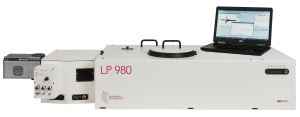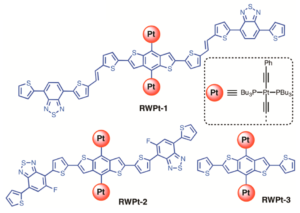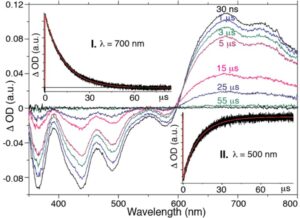Research Highlight: Enhanced Solar Cell Performance with Pt-based ‘Roller-Wheel’ Molecules; Utilising Transient Absorption for Excited State Energies and Lifetimes
Introduction
Engineering new materials with unique and valuable electronic and optical properties is paramount in the design of new devices from memory storage to creating the next generation of organic photovoltaic solar cells. Having the ability to measure and quantify the energies and lifetimes of photo-generated excited states is of utmost importance in the design of molecules that possess the desirable traits needed for these applications. Edinburgh Instruments has designed the LP980 Transient Absorption (Flash Photolysis) Spectrometer to be the world’s only commercially available spectrometer to feature dual detector options for direct kinetic and spectral measurements required for research into novel materials for solar energy conversion.

Figure 1: The Edinburgh Instruments LP980 Spectrometer.
Research
Under the direction of Prof. Jeffrey Rack and Prof. Yang Qin, researchers at the University of New Mexico have designed and synthesized exceptional Pt-based molecular “Roller-wheels” (Figure 2, RWPt) that demonstrated a solar cell power conversion efficiency (PCE) up to 5.9% for the RWPt-2 complex, better than any previous Pt-based solar material by 2%. Pt-based materials offer large-spin orbit coupling and square-planarity that can give rise large oscillator strengths of ground and exited states and ordered crystalline structures required to harness light and shuttle electrons.

Figure 2: The Pt-based “Roller-Wheel” complexes engineered for solar harvesting studied in this research.
These researchers systematically varied the conjugation length of the RWPt complexes and studied the optical properties, morphology, and electrical properties by various analytical techniques including cyclic-voltammetry, X-ray diffraction, transient absorption, and solar device performance. In the solid state, it was discovered that these molecules pack in a “slip-stack” fashion, facilitating crystallinity and charge mobility in solar cells. Transient absorption spectra and lifetimes of RWPt-2 (Figure 3) showed two distinct lifetimes, congruent with two non-interacting localised triplet states gleaned from RWPt-1 and RWPt-3 transient data that exhibits both p-p* and intermolecular charge transfer character with additional DFT calculations supporting the formation of these excited states.

Figure 3: Transient absorption spectra and kinetics of RWPt-2, utilising ICCD and PMT detectors on the LP980 Spectrometer.
Conclusion
Since photonic materials for solar cells rely on the interplay and energetic positions of the singlet and triplet excited state manifolds, the Edinburgh Instruments LP980 Transient Absorption Spectrometer is ideally suited to provide these triplet-state measurements for next generation materials to be used in solar devices.
Link to Article: https://pubs.acs.org/doi/abs/10.1021/jacs.7b05801
Figures reprinted with permission from J. Am. Chem. Soc. 2017, 139, 14109-14119.
Download this Research Highlight
Download a PDF of this Research Highlight here: Enhanced Solar Cell Performance with Pt-based ‘Roller-Wheel’ Molecules; Utilising Transient Absorption for Excited State Energies and Lifetimes
Stay in touch
If you have enjoyed this research highlight and would like to be the first to know about out future application notes, blog posts and news stories, please take a moment to join us on social media and sign up to our infrequent eNewsletter via the link below.








